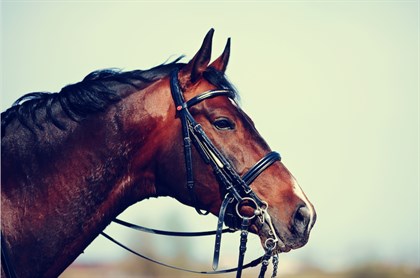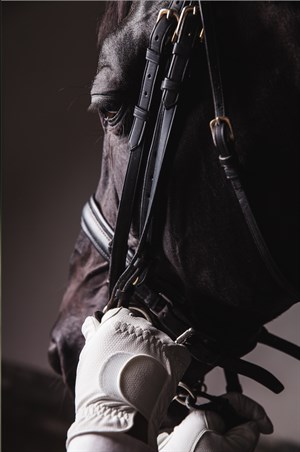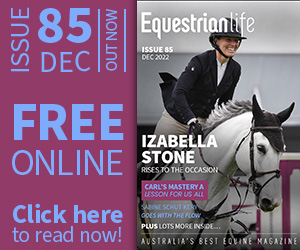
Tight nosebands, crank nosebands and double bridles are all part and parcel of the modern equestrian rider’s resources. But are they putting the horse under stress? Australian scientists are leading the research.
BY KERRY MACK
SCIENCE IS ALL about asking questions. When a scientist asks a question by doing an experiment, the most common outcome is that the answer they find just leads to more questions. And so science progresses from apparently simple questions such as, why do apples fall down off trees (rather than another direction) to what happens when two positrons collide in the Large Hadron Collider! Knowledge is acquired in little steps. There are levels of evidence which guide us as to the reliability of findings.
Most science starts from asking a question about something someone has observed. This can be a case report where a scientist notices something. Then they might design a study that takes a group (of horses, patients) which is called a cohort, and do research that might answer a small question, eg: “What happens if we do this? For example, tighten a noseband. From each experiment it is likely that a question will be answered and a few more questions become apparent. In designing an experiment the scientist will get advice from statisticians to know how many subjects are needed to find a significant result. The significance of a result is expressed as a P value. The smaller the P value, the more significant the finding. An oversimplified way to understand this is, for example, that if P=0.01, the chance of a difference between two groups being a coincidence is one in 100. If P=0.001 it suggests the chance of the difference between the two groups being a coincidence is one in 1000. Now, this is not an explanation accepted by a statistician as it’s too oversimplified, but it gives you an idea.
The great noseband experiment
Recently an experiment looking at the effect of nosebands on horses has also resulted in more questions than answers. Kate Fenner is part of a team headed up by Paul McGreevy at the University of Sydney’s Faculty of Veterinary Science, who have been gathering objective evidence about horse welfare. McGreevy’s team has done groundbreaking work looking at the effect of whips on racehorses that was used to inform practise in racing. That is the point of science; to inform us and to change what we do. Even if science tells us something unexpected or counter-intuitive, we should take the time to think about it.
Kate and her team asked questions about “what is it like to be a horse and wear a noseband and double bridle?”, and “Does the tightness of the noseband make a difference to the horse’s experience?” They were able to test 12 horses for signs of stress in response to different pressure nosebands. There were four groups: (1) not fastened; (2) fastened with two-finger spacing (3) fastened with one finger’s spacing; (4) fastened with no space. All horses wore double bridles and each horse went in each group.
Stress was measured in several different ways, all of which have been accepted by other scientists as a valid measure of stress on horses. We can't know what the experience of the horse is, but by measuring objective signs of distress we can learn something about the subjective experience of the horses.
The answers were pretty interesting. Horses didn't find wearing a noseband and double bridle significantly more stressful than baseline, until the noseband was done up tightly enough that there was no space between the noseband and the nose. The difference between the stress levels for baseline (unfastened noseband), and the firm noseband, were highly significant, up to p=0.001. Now, this is actually much less tight than many horses wear today. These nosebands were not “cranked up”, just fitting firmly. Kate said: “All the horses looked relaxed while we monitored them. There were no obvious outward signs of stress.” A judge looking at these horses would not have seen evidence of stress which would be penalised in a harmony mark. However, when the data from the monitors was analysed, it showed that when the nosebands were done up firmly, the horses were stressed. The double bridle did not cause stress on its own.
One of the unexpected findings was that when the video was analysed of the horses’ behaviour, there was a significant reduction in normal mouth movements, including chewing, yawning and swallowing (P=0.001). Not only that, but when the noseband was loosened there was a compensatory increase in licking, swallowing and chewing. This increase also suggests that the reduction in the behaviour was a significant stressor for the horse. This is known as a post-inhibitory rebound, where the horse performs the behaviour more frequently immediately after it has been prohibited from doing so (a bit like a horse that has been locked in a stable and runs around the paddock bucking) and is thought to indicate a welfare risk.
This is really interesting for a couple of reasons. The judges interpret chewing, grinding and busy tongues as a sign of stress, definitely not as a sign of relaxation. Just take a moment to think about the task of being a judge. Each move may take 15-25 seconds. In that time a judge must evaluate the correctness of the movement according to the training scale and the definitions, eg: for a shoulder-in the rhythm suppleness, contact, impulsion, straightness, collection, and the angle, bend, etc. as well as any signs of tension such as a “busy” mouth.
So it's understandable that judges often see a busy mouth and penalise it. It's something that they can see easily and that gets their attention. Further, a still, foaming mouth is taken as a sign that the horse is relaxed. And yet this study suggests that perhaps the horse with the still mouth and lots of foam may actually be stressed and have an overtight noseband that interferes with normal swallowing. Less swallowing, more saliva, a nice foamy mouth that the judges like. Remember that in Kate's research there were no obvious signs of stress.
Crank it down (not up)
The crank noseband is not a bad piece of equipment. Of course, it can be used badly. The pulley mechanism does allow it to be done up far tighter than just firm. However, it also has a flat padded piece of leather over the sensitive jaw bones which protects the jaw from uneven pressure from a buckle. The crank does not need to be done up tightly. All equipment is only as good or bad as the person using it. Kate makes the point: “It's not only the elite riders and professional riders who may be tightening up nosebands. The professional riders lead the way, they are the coaches. Less experienced riders may be following the lead. The problem with tight nosebands is probably not just at the top of the sport.”
Some of the questions raised by this research may be difficult to answer. Is it the same for horses used to this equipment? There is a piece of research which suggests that horses do not habituate (the scientific word for “gets used to”) to pressure in the mouth. This suggests that horses experienced with tighter nosebands may not habituate to the noseband, but we don't know.
What is the effect of really tight crank nosebands where the pulley effect is used to tighten up the noseband? What is the effect of the tighter noseband on the poll? We would expect that a tight noseband will increase poll pressure also as it holds the bridle down.
Does padding underneath the noseband make any difference to the experience of the horse to ameliorate the effect of cranking the noseband? What is the pressure on the nose that makes a difference?
These two questions could be answered if a pressure transducer could be introduced into the protocol. One study which did measure pressure under nosebands in horses’ normal bridle showed pressures around 350mmHg. Recall that blood pressure is measured in mmHg. Imagine a blood pressure cuff pumped up this tight. Pretty uncomfortable.
So, you can see how in science, finding results can lead to more questions. We can't always wait for all the answers and can sometimes act without all the facts. This research supports a change of practise towards the traditional measurement of a cavesson to be two fingers. ISES has recommended use of a special tool to measure a standardised fit. The ISES gauge also has a one-finger marker which would work.
Ensure your noseband complies with the two finger rule.
We do not at this time know the whole significance of these findings, but if we have integrity about welfare then we should at least be curious. We should not ridicule or denigrate people who are genuinely trying to gather objective evidence about the experience of our horses; these researchers are not greenies or cranks, as they have been portrayed in some media. If we are truly on the side of the horse then we are on the same side as these researchers. Let's have an educated discussion about it.
READ THE LATEST NEWS ARTICLES HERE
https://www.equestrianlife.com.au/articles/Nosebands-a-pressing-issue_


